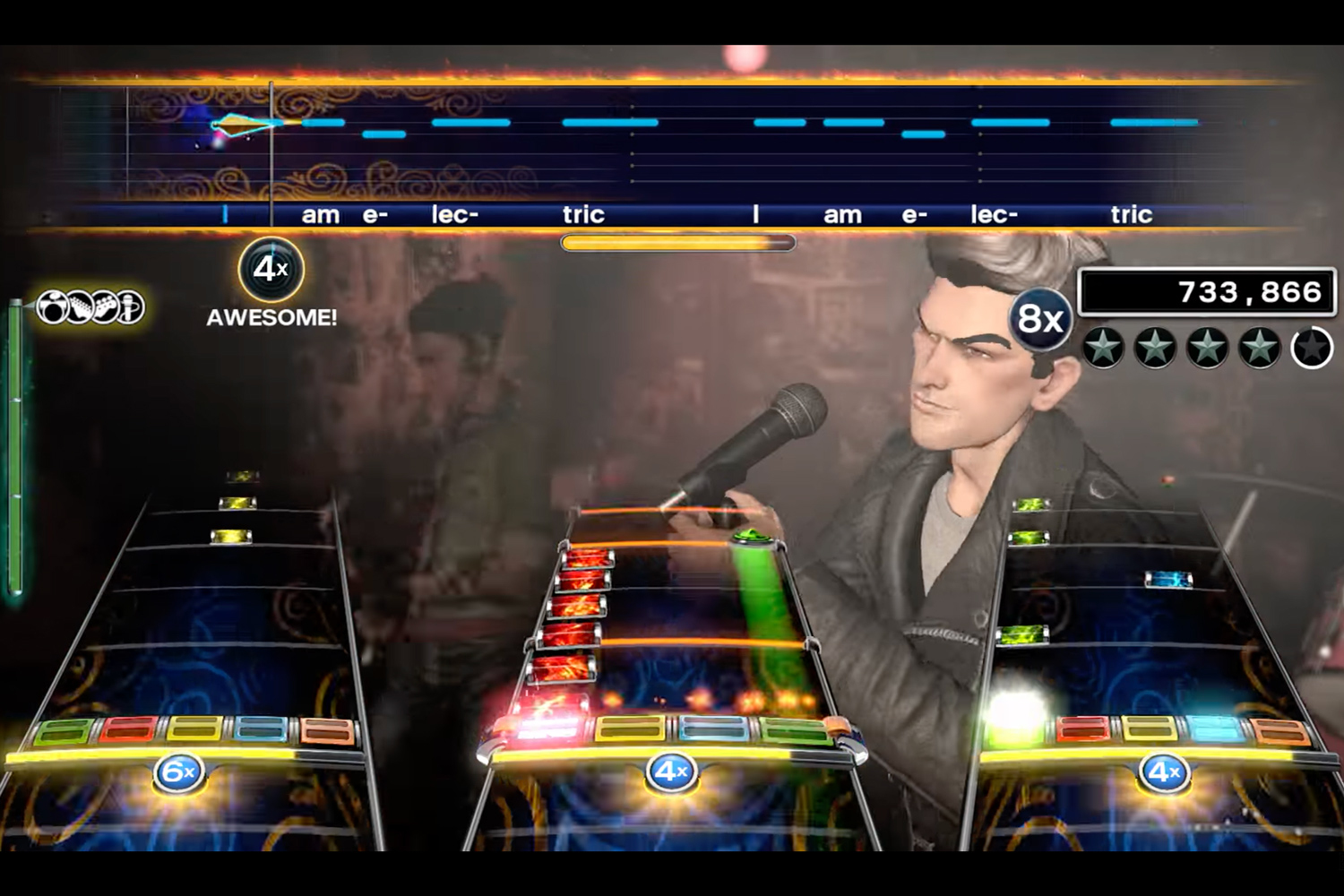Harmonix keeps innovating, with lasting impact
The MIT spinout has been releasing iconic video games for more than 25 years.

Every holiday season, a popular new video game causes a disproportionate amount of hype, anticipation, and last-minute shopping. But few of those games offer an entirely new way to play. Even fewer have ripple effects that reach far beyond the gaming universe.
When Guitar Hero was released in 2005, challenging players to hit notes to classic rock songs on guitar-like controllers, it grew from a holiday hit to a cultural phenomenon that taught a new generation to love rock ‘n’ roll music. Along the way, it showed the video game industry the power of innovative, music-based games.
Guitar Hero and the related Rock Band franchise were developed by Harmonix Music Systems, which formed more than 25 years ago in MIT’s Media Lab when a pair of friends began using technology to help people interact with music. Since then, it has released more than a dozen games that have helped millions of people experience the thrill of making music.
“The thing that we’ve always tried to accomplish is to innovate in music gameplay,” says Eran Egozy ’93, SM ’95, a professor of the practice in music and theater arts at MIT who co-founded the company with Alex Rigopulos ’92, SM ’94. “That’s what the company is constantly trying to do — creating new kinds of compelling music experiences.”
To further that mission, Harmonix became a part of industry giant Epic Games last month. It’s a major milestone for a company that has watched its games go from small passion projects to ubiquitous sources of expression and fun.
Egozy has seen Harmonix games on famous bands’ tour buses, in the offices of tech giants like Google, at bars hosting “Rock Band nights,” and being portrayed in popular TV shows. Most importantly, he’s heard from music teachers who say the games inspired kids to play real instruments.
In fact, Egozy just heard from his son’s school principal that the reason he plays the drums is because of Rock Band.
“That’s probably the most gratifying part,” says Egozy, who plays the clarinet professionally. “Of course, we had great hopes and aspirations when we started the company, but we didn’t think we would actually make such a big impact. We’ve been totally surprised.”
Mission-driven beginnings
As an undergraduate at MIT, Egozy majored in electrical engineering and computer science and minored in music. But he never thought about combining computers and music until he participated in the Undergraduate Research Opportunities Program under then-graduate student Michael Hawley in the Media Lab.
The experience inspired Egozy to pursue his master’s degree at the Media Lab’s Opera of the Future group, led by Tod Machover, where he began building software that generated music based on intuitive controls. He also met Rigopulos at the Media Lab, who quickly became a friend and collaborator.
“Alex had this idea: Wouldn’t it be cool if we took a joystick that’s a more friendly interface and used it to drive the parameters of our generative music system?” Egozy recalls.
The joystick-based system immediately became one of the most popular demos at the Media Lab, leading the pair to participate in the MIT $10K Entrepreneurship Competition (the MIT $100K today).
“I think MIT imbued me with a sense that there’s no point in trying to do something that someone’s already done,” Egozy says. “If you’re going to work on something, try to do something inventive. That’s a pervasive attitude all around MIT, not just at the Media Lab.”
As graduation arrived, Egozy and Rigopulos knew they wanted to continue working on the system, but they doubted they could find a company that would pay them to do it. Out of that simple logic, Harmonix was born.
The founders spent the next four years working on the technology, which led to a product called Axe that Egozy describes as a “total flop.” They also built a system for Disney at the Epcot amusement park and tried to integrate their software with karaoke machines in Japan.
“We sustained multiple failures trying to figure out what our business was, and it took us quite a while to discover the way to satisfy our mission, which is to let everyone in the world experience the joy of making music. As it turns out, that was through video games,” Egozy says.
The company’s first several video games were not huge hits, but by iterating on the core platform, Harmonix was able to steadily improve on the design and gameplay.
As a result, when it came time to make Guitar Hero around 2005, the founders had music, graphics, and design systems they knew could work with unique controllers.
Egozy describes Guitar Hero as a relatively low-budget project within Harmonix. The company had two games in development at the time, and the Guitar Hero team was the smaller one. It was also a quick turnaround: They finished Guitar Hero in about nine months.
Through its other releases, the Harmonix team had been trained to expect most of its sales to come in the weeks leading up to the Christmas holiday and then for sales to essentially stop. With Guitar Hero, the game sold incredibly quickly — so quickly that retailers immediately wanted more, and the company making the guitar controllers had to multiply their orders with manufacturers.
But what really surprised the founders was that January’s sales surpassed December’s. … Then February’s surpassed January’s. In fact, month after month, the sales graph looked like nothing Harmonix’s team of 45 people had ever seen before.
“It was mostly shock and disbelief within Harmonix,” Egozy says. “We just adored making Guitar Hero. It was the game we always wanted to make. Everyone at Harmonix was somehow involved in music. The company had a band room just so people could go and jam. And so the fact that it also sold really well was extremely gratifying — and very unexpected.”
Things moved quickly for Harmonix after that. Work on Guitar Hero 2 began immediately. Guitar Hero got taken over by Activision, and Harmonix was acquired by MTV Networks for a number of years. Harmonix went on to develop the Rock Band franchise, which brought players together to perform the lead guitar, bass, keyboard, drums, and vocals of popular songs.
“That was really wonderful because it was about a group effort,” Egozy says. “Rock Band was social in the sense that everyone’s together in the same room playing music together, not competitively, but working toward a common goal.”
An ongoing legacy
Over the last decade, Harmonix has continued to explore new modes of music gameplay with releases such as SingSpace, which offers a social karaoke experience, and Fuser, a DJ-inspired game that lets users mix and match different tracks. The company also released Rock Band VR, which makes players feel like they’re on stage in front of a live audience.
These days Egozy, who’s been on the board since he became a full-time professor at MIT in 2014, teaches 21M.385/6.185 (Interactive Music Systems), a class that combines computer science, interaction design, and music. “It’s the class I wish I had as an undergrad here at MIT,” Egozy says.
And every semester, the class takes a tour of the Harmonix office. He’s often told it’s students’ favorite part of class.
“I'm really proud of what we were able to do, and I’m still surprised and humbled by the cultural impact we had,” Egozy says. “There is a generation of kids that grew up playing these games that learned about all this music from the ’70s and ’80s. I’m really happy we were able to expose kids to all that great music.”





































